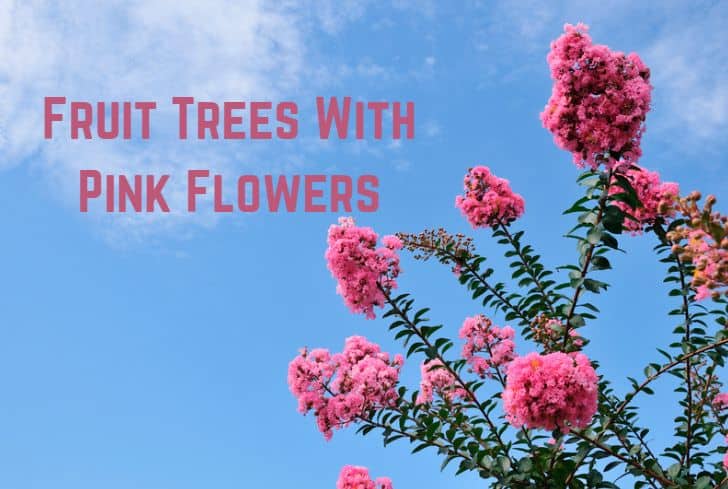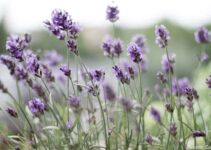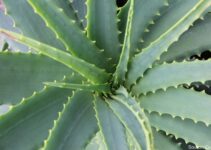Are you looking for inspiration for your next arbor addition to your garden or yard space? Flowering trees add visual interest and attract beneficial insects like bees and butterflies to your yard. They also can produce delicious fruit or berries that you can enjoy fresh or make into teas, jams, jellies, or other preparations.
Here are 13 fruit trees with pink flowers to help you decide which floral beauty to add to your garden next!
13 Fruit Trees With Pink Flowers
1. Crape Myrtle
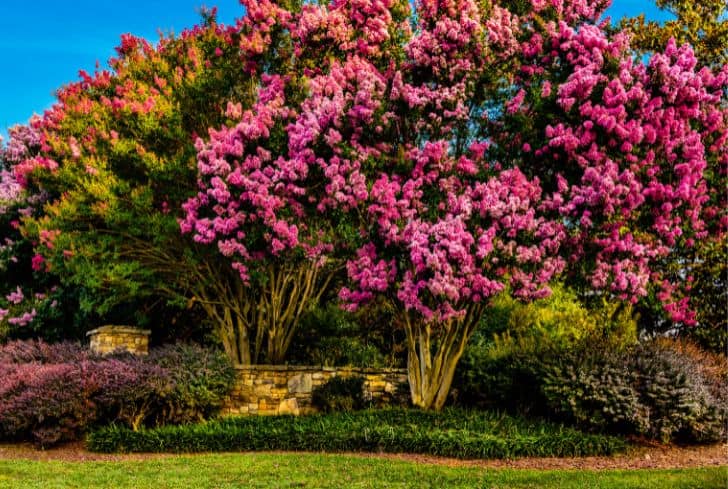
Perhaps one of the most iconic and beautiful pink flowering trees in the United States is the crape myrtle. The tree boasts stunning clusters of pink, white, or purple flowers in the late spring or early summer. Usually, the tree can be found as part of landscaping in the southern parts of the country, and it’s a common choice to add beauty to parks and public outdoor spaces.
Crape myrtles are relatively low maintenance and require little intervention or pruning as they mature. Be sure to plant your crape myrtle in well-draining soil and in an area with lots of sunshine to help ensure beautiful blooms each season.
2. American Beautyberry

While the American beautyberry is actually classified as a shrub, this southeastern United States native blooms beautiful pink flowers in the summer and salt fall. Thanks to its compact size and shape, it’s common to see the American beautyberry used in landscape and garden designs. Some landscapers and homeowners like to use this shrub to create a natural privacy hedge.
The American beautyberry offers more than privacy and beauty; the berries it produces are edible and are commonly enjoyed in jam and jellies. If you are hoping to create a natural barrier that will offer delicate pink flowers and delicious berries, consider growing the American beautyberry shrub in your garden.
3. Barbados Cherry Tree

Another shrub that offers both pink flowers and delicious edible berries is the Barbados cherry tree. While similar to the American beautyberry in size, the Barbados cherry tree is an evergreen shrub, meaning it doesn’t lose its foliage in the winter months. The shrub is native to warmer regions like Mexico, Central America, and the West Indies and can be identified by its glossy leaves and clusters of tiny flowers,
As for the berries of the Barbados cherry tree, they are bright red. These berries are a favorite for birds and other wildlife thanks to their sweet flavor. Humans also enjoy the fruit and like to grow the Barbados cherry tree for easy access to delicate pink flower clusters as well as delicious berries.
4. Dogwood Tree
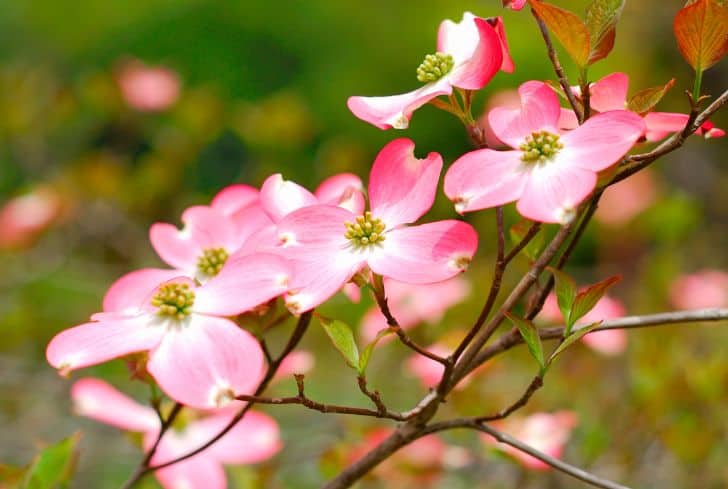
One of the most popular flowering trees to be grown in North America is the dogwood tree. Thanks to their relatively low maintenance care routine and the ability to grow in a multitude of soil types, dogwood trees can be found throughout the United States. A dogwood tree grows to be about 25 feet tall and will produce small pink flowers after it reaches maturity.
Dogwood trees can tolerate occasional droughts and even flooding. They also tend to be pest and disease resistant, making them a perfect choice for homeowners looking to create some shade in their outdoor spaces. They bloom with delicate pink flowers in the springtime each season, adding some color to the otherwise bare landscape after a long winter season.
5. Star Magnolia

Another American classic is the star magnolia tree. Blooming with beautiful pale pink flowers with a strong floral fragrance, it’s no surprise that many homeowners and landscapers like to include these unique trees in their designs. As the star magnolia tree grows, it will begin to form an oval shape as the top grows taller, but the spread stays the same.
While star magnolia trees produce pink flowers, there are plenty of types of magnolia trees available throughout the United States. Some are evergreen, while others are deciduous. Today, many magnolia trees and shrubs are hybrids, making them more resilient and able to be grown in different climates and regions.
6. Japanese Apricot Trees

While all fruit trees produce flowers, not all fruit trees bloom pink. However, the Japanese apricot tree does produce delicate pink flowers each season. The flowers are used to attract bees, butterflies, and other pollinators to help pollinate the tree. The tree needs to be pollinated to produce fruit, in this case, Japanese apricots.
The Japanese apricot tree blooms from early spring until late summer, producing fruit after the flowers have faded. These trees are common to find in Japanese gardens, and the fruits are commonly used in Japanese dishes, especially traditional ones. However, many people just simply enjoy the look of the tree and its flowers and don’t grow the tree for its edible fruit.
Not all fruit grown on shrubs, bushes, or trees is edible, so it’s always important to know which type of plant you are gathering the fruit from before consuming it.
7. Quince Tree

Quince trees are not commonly thought of when listing flowering fruit trees. They were once very popular, but with the inability to eat the fruit straight from the plant, they went grown as often and are now rare. Quince trees flower in yellows, pinks, and reds. If you are hoping to grow the tree only for its floral display, purchasing a flowering quince is the right choice.
Quince trees produce yellow or green fruit that is often shaped like an apple or a pear. While the fruit itself is very tart, it is often used in jams or jellies. So few people grow or want quince fruits that the USDA doesn’t track them. If you are hoping to grow your own quince tree for fruit, purchasing a young tree from a modern cultivator will be your best chance.
8. Crabapple
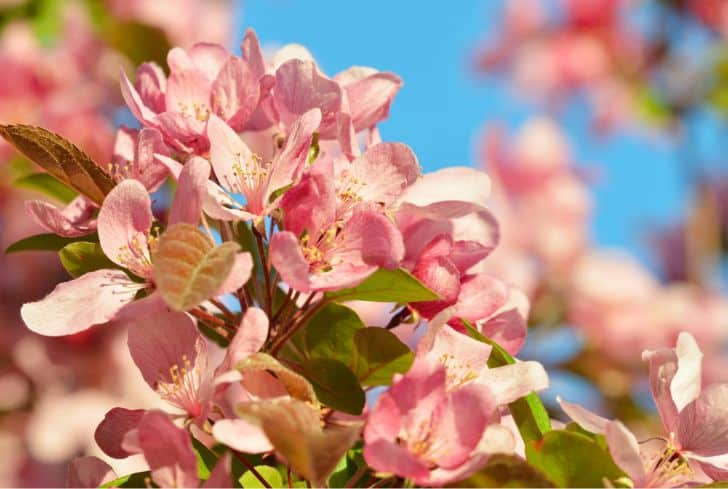
Crabapple trees are grown for a multitude of reasons. The tree itself is a unique shape, adding visual interest to garden and landscape designs. Another reason that people like to grow crabapple trees is because of the stunning pink or white flowers that it produces each spring.
These flowers will eventually turn into crabapple fruit if the flower is pollinated by bees, butterflies, other insects, or the wind during its bloom time. The crabapple fruit is ripe around the end of summer and can be used to make jams or jellies.
Crabapple trees are native to North America and Europe and are commonly found in wooded areas and hedgerows when found in the wild.
9. Eastern Redbud
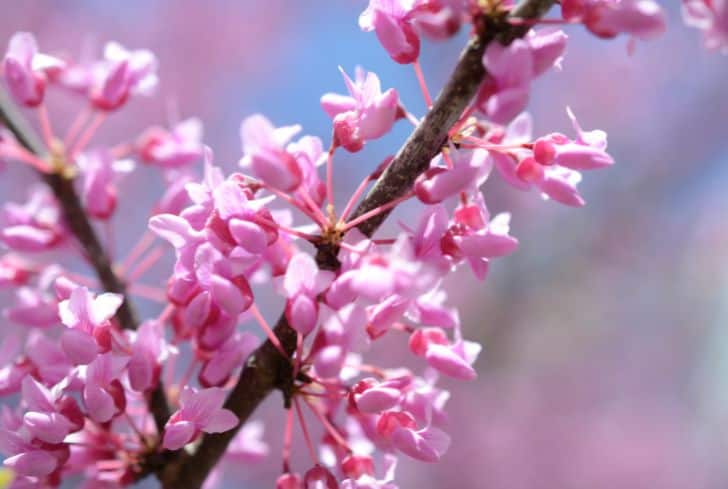
The eastern redbud tree offers a unique springtime visual experience. The flowers of the eastern redbud appear before the leaves reemerge after a long winter. Small clusters of deep pink flowers will decorate the tree’s branches without any green leaves for their backdrop, making a visually interesting addition to any landscape.
The eastern redbud is actually a member of the legume family. Instead of producing a traditional fruit, the fruit of an eastern redbud tree looks similar to a pea or bean that hangs from the branches. Many people grow the eastern redbud as an ornamental tree, but the fruit is edible.
10. Peach Tree

While many people think of the state of Georgia when they hear peach trees, these trees are actually native to China. Peach trees are grown mainly for their fruit, peaches. However, these trees also produce stunning pink or purple foliage in the spring.
Peach trees tend to bloom at the end of springtime, but the exact timing will depend on the area’s weather. After the tree has bloomed, it will take a few weeks for the peach fruit to emerge. Peaches are commonly eaten fresh or canned and can be baked into pies and other desserts.
Peach trees require a little more attention than other types of flowering trees, so if you don’t care about peaches and want visual beauty, perhaps choose a different type of flowering tree.
11. Purple-leaf Plum Tree

Not only does the people-leaf plum tree bloom pink flowers in the springtime, but it also has stunning deep purple leaves making it an amazing addition to any outdoor or garden space. While the plant is native to Europe, it can be grown almost anywhere in the United States.
The purple-leaf plum tree matures to a height of 15-20 feet tall with a matching spread. Similar to other types of early-season blooming trees, the purple-leaf plum tree flowers before the leaves emerge, adding more visual appeal to this already unique and exciting tree.
The tree produces a small red fruit that can be used in jams or jellies, but the main reason people enjoy this tree is its foliage color and pink flowers.
12. Royal Poinciana Tree

A tropical tree from Madagascar, the royal poinciana tree grows between 30-50 feet tall and has a unique umbrella-shaped spread that is as wide as 40-60 feet. While the shape of the tree is unusual, perhaps the most striking feature of the royal poinciana tree is its flowers.
Each flower can grow as large as 4 inches in width and is the shape of a star with 5 petals. Usually, the flowers are deep red in color, but sometimes they do have a pink tinge to them.
The flowers are stunning individually but will bloom in large clusters of 20 blooms, creating a visual treat for passersby. The flowers also release an intoxicating floral fragrance attracting pollinators as well as humans.
The plant produces a legume fruit that can be used in jams or jellies.
13. Mimosa Tree
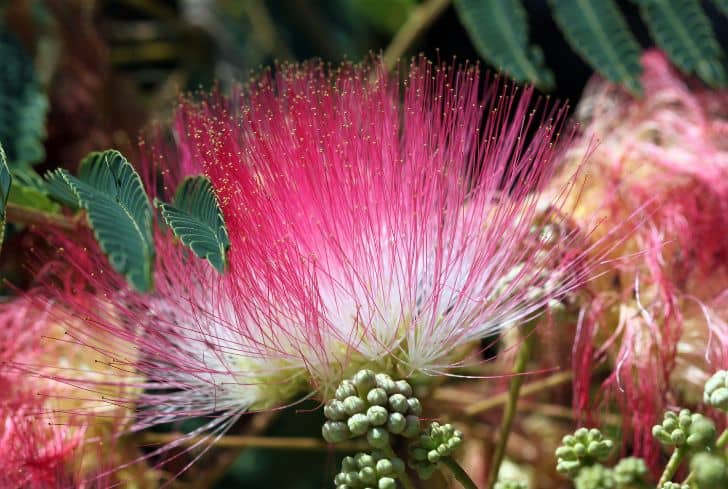
Another tree with unique flowers is the mimosa tree. Also called Chinese silk, Persian silk, or Albizia julibrissin, the mimosa tree is most known for its memorizable flowers, which look like small puffs and are usually pink in color. While native to Asia, they can be found throughout the southern part of the United States.
Many people don’t like to grow mimosa trees because they are an invasive species. They spread quickly and produce messy long strings of bean pods that are mildly toxic to humans and animals if ingested. They are also prone to disease and damage.
Others overlook the negatives of growing mimosa trees and enjoy their fern-like foliage and puffball flowers.
